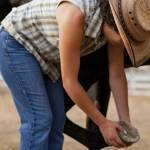Soft-Tissue Infections a Significant Cause of Equine Lameness

A study of the causes of lameness in horses has been carried out by researchers from the School of Veterinary Medicine and Science at The University of Nottingham in England. Somewhat surprisingly, the most common cause of lameness was not arthritis, muscle strain, or tendinitis. Among the 294 horses examined in the 13-month study, cellulitis, a bacterial infection of the connective tissues of the skin, caused lameness more often than any other factor.
The horses were all mounts from the Household Cavalry Mounted Regiment, a London-based division of the British Army. Their purpose is to carry out ceremonial duties on state and royal occasions such as coronations, weddings, and birthday celebrations for members of the royal family. The research team chose to use these horses because it was felt their level of work was more similar to that of the average pleasure horse than to racehorses or other performance equines.
The research team obtained data from questionnaires completed by farriers, riders, and others who cared for the study horses. For each incident of unsoundness, information was gathered on the type of lameness, time span when the horse was out of work, and whether the lameness resolved so that the horse was able to go back to work.
Among the horses in the study group, the monthly incidence of lameness was just over 2%. There were 16 cases of cellulitis, the leading cause. Most were related to small infected cuts, and the average time out of work was 17.5 days. There were 14 cases of skin wounds, the second most common cause of lameness, with an average time out of work of 25 days. The next five factors, in descending order, were problems with shoes or hooves, injuries to tendons or ligaments, arthritis, hoof abscesses, and bruised muscles.
The researchers felt that while arthritis and other major health conditions attract more publicity and research, lightly ridden pleasure horses may be affected more often by problems that are less serious and last for a shorter period of time. High-performance horses tend to be studied more, and their level of training and work may lead to different problems than those encountered by horses doing work of a less demanding type. Therefore, some data collected on racehorses and competition horses may not be applicable or relevant to horses with lower-level performance careers.








